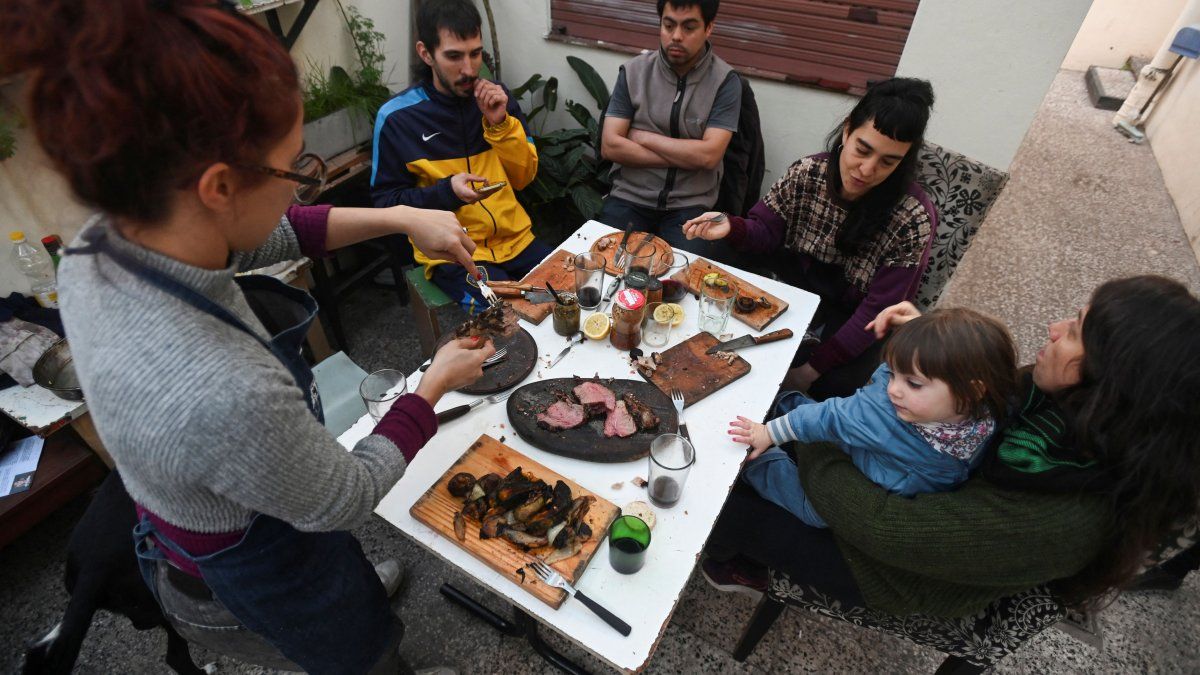According to CADAM, the price of sugar was felt most in desserts, yogurts, sweets, sausages and drinks in general, while there were higher purchases of basic products such as oils, flours and sugar.
But before Milei, the report “A look at the evolution of food consumption worldwide and in Argentina in the last six decades” (by Daniel Díaz, Andrea Goldberg, Rosa Fernández, Laura Barbieri and Andrea Graciano) compared that, while the apparent per capita consumption of food from 1961 to 2021 grew by 42% in the world, in Argentina it only grew by 4%, 10 times less.
Meat, milk and bread have historically been the pillars of the Argentine diet, according to the study.
Current behavior
To not go too far, consequently, the Livestock Market of the Rosario Stock Exchange (Rosgan) specified that the consumption of beef, during the first four months of the year, was 42 kilograms per capita: 4.5 kilos less than that recorded in the last four months of 2023 (48.5).
Consumption of fluid milk in the first half of the year fell by 19.6% and that of powdered milk by 30.4% compared to the same period last year.
Likewise, bakery sectors have reported a 45% drop in bread sales.
One explanation lies in the 34.1% drop in the purchasing power of the minimum wage published in April by the Research and Training Centre of the Argentine Workers’ Central (Cifra-CTA).
Another possibility is that, at the end of March, in the richest district of the country there were more than a million poor people, of which some 470 thousand were destitute, who cannot even afford the food basket, that is, 155 thousand more have been added since the fourth quarter of last year, according to the Statistics and Census Directorate of the City of Buenos Aires.
Meat
According to the Chamber of Industry and Commerce of Meat and Derivatives of Argentina, meat production in the first four months of the year amounted to 988 thousand tons, which was a 7.7% year-on-year decrease.
Of this total supply, 324 thousand tons were exported and 664 thousand tons remained for domestic consumption, 17.5% lower than that recorded in the first four months of last year.
“The apparent consumption of beef per inhabitant would be about 42.4 kilos per year in the first four months of 2024, which is 18.5% lower than that recorded in the same period of 2023, the lowest in the last three decades,” Rosgan said.
The Rosario Stock Exchange also notes that indicators for the pig sector have declined.
Pig production totals 174,000 tonnes, down 2.4% year-on-year.
As for consumption, they specified, it totaled 177,000 tons in the first quarter, falling 4% year-on-year and below 2022 and 2023 in the same period.
Per capita consumption has thus fallen by one kilo per inhabitant compared to last year, standing at 15.2 kilos per inhabitant per year.
“Today, people only buy beef to indulge themselves; meat consumption in the first four months of this year fell by 17.5%,” said Miguel Schiariti, director of the Chamber of Meat Industry and Commerce of the Argentine Republic (CICCRA).
He recalled that in 2001 there was a similar scenario, although he differentiated that at that time “people did not have money” and that they chose to replace the consumption of animal protein with potatoes, noodles and rice.
He also compared the fact that, as far as statistics show, the price of one kilo of beef could buy three kilos of chicken or two kilos of pork.
Of the 109.4 kilos per inhabitant per year of animal protein consumed by the average Argentine in 2021, 47.8 were beef and represented only 44% of the total, when at the beginning of this millennium they reached between 60 and 70%, the Rosario Stock Exchange stressed.
The figure reached its lowest level since 1920, more than 100 years ago, and according to research conducted by Alberto Lugones and Emilce Terré, the low share of beef in the Argentine diet is due both to the choice of plant-based foods and the incorporation of other types of meat.
The head of the Internal Promotion Department of the Argentine Beef Promotion Institute (Ipcva), Adrián Bifaretti, broke it down: “In the country, 70% of the population is a very traditional carnivore. 7% is a veggie population, that is, vegans and vegetarians who are not consuming meat. And another 24% or so who are flexitarians. People who, despite eating everything, are reducing their consumption of meat products and prioritizing the consumption of foods of plant origin, and the trend is for this to deepen.”
However, in 2023 there had been an increase in meat consumption of 3 points kilograms per inhabitant compared to 2022 and it stands at 51.1 kg, almost 3 points more than in 2022.
Bifaretti analyzed “two basic questions”: one is a structural decline that has to do with changes in the eating habits of the population, especially in the younger segments, many of whom are beginning to not want to eat meat for ethical and moral reasons linked to meat and the environment,” but they do not go far enough to explain this year’s consumption.
“Obviously, there is also the issue of money and finances. When you look at the possibilities of the population, there is a significant limitation in acquiring not only meat, but other types of food and goods,” he added.
Milk
At the end of the first quarter of the year, milk sales dropped by 18.7% in tons of product, compared to the same period in 2023, while in equivalent liters it was 15.3%, according to the report of the Institute for Argentine Agroindustrial Development.
As for fluid milk, consumption accumulated a fall of 19.6%, while powdered milk fell by 30.4%, in tons and compared to the first three months of 2023.
According to the report, there was also a drop in cheeses, which represent 60% of dairy consumption, by 10.4%, measured in tons.
The decrease covered all dairy products, although the largest one, as in “those with the highest added value and per unit such as very soft cheeses, grated cheeses, flavored milks, yogurts, flans and desserts, was associated with price increases and the delay in the purchasing power of the middle sector of the population that demands these products in greater quantities,” explained the Argentine Dairy Chain Observatory (OCLA), created by companies in the dairy chain and agricultural entities such as Crea, Coninagro and Sociedad Rural.
Bread
The president of the Centro Industrial de Panaderos de Merlo, Martín Pinto, estimated that “we have a 45% drop in sales in all bakeries in Argentina. People are not consuming.”
The leader acknowledged the sharp increase in prices in this area in recent months, following the elimination of the Argentine Wheat Stabilizing Fund, created in March 2022 to subsidize flour and set a reference value for the domestic market.
“It was an important achievement of the previous government because it removed flour from the orbit of the dollar,” said Pinto.
The mechanism was created after the outbreak of the war between Russia and Ukraine – two leading countries in the world wheat market – which led to a global rise in grain prices.
The objective was to “stabilize the cost of the ton of wheat purchased by Argentine mills” in order to “maintain stability in the share of the bag of flour as a component of the cost of products derived from it.”
In April of this year, through Resolution 142/2024, it was decided to liquidate the Argentine Wheat Stabilizing Fund, along with other trust funds, such as the Urban Socio-Integration Fund or the National Teacher Incentive Fund, among them, under the argument of reducing State expenses.
In the case of wheat, it enabled the dollarization of the price of cereal and the increase in the price of bread and derivatives.
Source: Ambito




